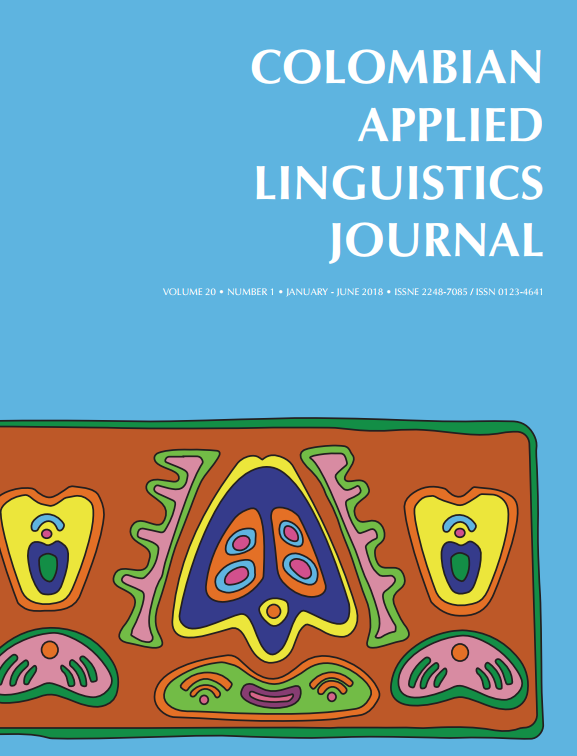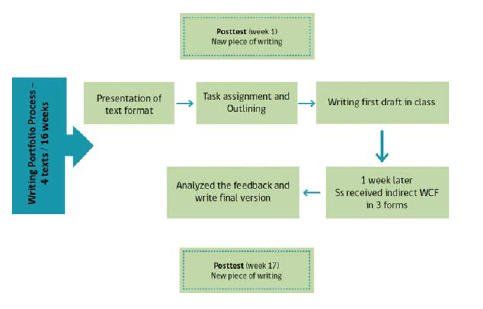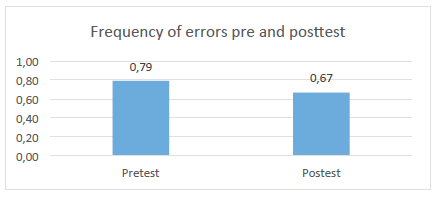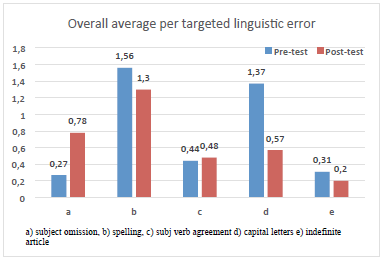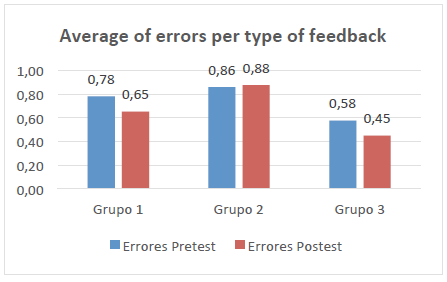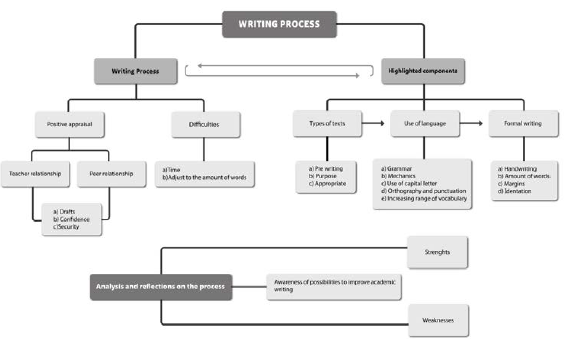DOI:
https://doi.org/10.14483/22487085.12332Published:
2018-02-16Issue:
Vol 20, No 1 (2018) January-JuneSection:
Research ArticlesCombining the strategies of using focused written corrective feedback: a study with upper-elementary Chilean EFL learners
Combinar las estrategias de uso de retroalimentación correctiva escrita enfocada: un estudio con estudiantes chilenos de EFL de nivel primario superior
Keywords:
portafolio de escritura, versiones mejoradas, inglés como idioma extranjero, indirecto, focalizado, FCE (es).Keywords:
Indirect, focused WCF, writing portfolio, multiple drafting, EFL (en).Downloads
References
Aydin, S. (2010). EFL writers’ perceptions of portfolio keeping. Assessing Writing, 15: 194-203. July 2016 http://www.elsevier.com
Baleghizadeh, S. & Dadashi, M. (2011). The Effect of Direct and Indirect Corrective Feedback on Students’ Spelling Errors. Profile 13-1, 129.137.
Bitchener, J., Young, S., & Cameron, D. (2005). The effect of different types of corrective feedback on ESL student writing. Journal of Second Language Writing 14: 191-205.
Bitchener, J. (2008). Evidence in support of written corrective feedback. Journal of second language writing, 17, 102-118. doi:10.1016/j.jslw.2007.11.004
Bitchener, J. & Knoch, U. (2010). The contribution of written corrective feedback to language development: A ten month investigation. Applied Linguistics, 31 (2), 193-214.
Bitchener, J. & Knoch, U. (2010). Written corrective feedback and advanced ESL learners. Journal of Second Language Writing, 19, 207-217.
Campion, C. (2004). Spelling Proficiency of Native Speakers of Spanish: A Look at the Influence of Morpheme Structures in Spelling Errors. The UCI undergraduate research journal. 19-26
Chandler, J. (2003). The efficacy of various kinds of error feedback for improvement in the accuracy and fluency of L2 student writing. Journal of Second Language 12:267-96.
Ellis, R. (2009). A typology of written corrective feedback types. ELT Journal, 62(2). ; doi:10.1093/elt/ccn023
Flick, U. (2004). Introducción a la investigación cualitativa. Madrid: Morata.
Lam, R. (2013). Two Portfolio Systems: EFL students’ perceptions of Writing Ability, text improvement, and feedback: 18, 132-153. Retrieved July 2016 http://www.elsevier.com
Ferris, D., Liu, H., Sinha, A., Senna, M. (2013). Written corrective feedback for individual L2 writers. The Journal of Second Language Writing: 22, 307-329. http://dx.doi.org/10.1016/j.jslw.2012.09.009
Ferris, D. (2006). Does error feedback help student writers? New evidence on short-and-long-term effects of written error correction in. Hyland, K. and Hyland, F. (eds.).Feedback in Second Language Writing. Contexts and Issues. Cambridge: Cambridge University Press.
Ferris, D. (2003). Response to student writing: implications for second language students: Routledge.
Hyland, K. and Hyland, F. (2006).Feedback in Second Language Writing. Contexts and Issues. Cambridge: Cambridge University Press.
Kaminsky, D. E. (1993). Helping Elementary English as a second language students to become independent learners by improving their reading strategies. (ERIC Document Reproduction Service No. ED36510).
Kepner, C.G. (1991). An experiment in the relationship of types of written feedback to the development of second language writing skills. Modern Language Journal, 75, 305-313.
Lee, I. (2004). Error correction in L2 secondary writing classrooms: The case of Hong Kong. The Journal of Second Language Writing, 13, 285–312. doi:10.1016/j.jslw.2004.08.001
Lee, I. (2008). Understanding teachers’ written feedback practices in Hong Kong secondary classrooms. Journal of Second Language Writing, 17, 69-85. doi:10.1016/j.jslw.2007.10.001
Nezakatgoo, B. ( 2011). The Effects of Portfolio Assessment on Writing of EFL Students. English Language Teaching.4, 232-241. Retrieved, July 2016 http://files.eric.ed.gov/fulltext/EJ1080736.pdf
Sheen, Y., Wright, D., & Moldava, A. (2009). Differential effects of focused and unfocused written correction on the accurate use of grammatical forms by adult ESL learners. System, 37(4), 556-569.
Sheen, Y. (2007). The effect of focused written corrective feedback and language aptitude on ESL learner’s acquisition of articles. TESOL Quarterly 41, 255-283.
Stortch & Tapper (2000). The focus of teacher and student concerns in discipline-specific writing by university students. Higher Education Research and Development, 19(03), 337-355.
Truscott, J. (1996). The case against grammar correction in L2 writing classes. Language learning 46, 327-369.
Truscott, J. (1999). The case for “the case against grammar correction in L2 writing clases”: a response to Ferris”. Journal of Second Language Writing, 8(2), 111-122.
Truscott, J. (2007). The effect of error correction on learners’ ability to write accurately. Journal of Second Language Writing, 16, 255–272. doi:10.1016/j.jslw.2007.06.003
How to Cite
APA
ACM
ACS
ABNT
Chicago
Harvard
IEEE
MLA
Turabian
Vancouver
Download Citation
Combining the strategies of using focused written corrective feedback and keeping a writing portfolio1
Combinar las estrategias de uso de retroalimentación correctiva escrita enfocada: un estudio con estudiantes chilenos de EFL de nivel primario superior
Pamela Andrea Saavedra2
Mónica Campos Espinoza3
1 This research Project has received the support from Plan de Mejoramiento Insitucional (PMI) UCT1312. Convenio de Desempeño para la Formación Inicial de Profesores.
2 Universidad Católica de Temuco, Chile. psaavedra@uct.cl
3 Universidad Católica de Temuco, Chile. mcampos@uct.cl
Citation/ Para citar este Artículo: Saavedra, P. & Campos, M. (2018). Combining the strategies of using focused written corrective feedback and keeping a writing portfolio. Colomb. appl. linguist. j., 20(1), pp. 79-90.
Received: 25-Jul.-2016 / Accepted: 20-Dec.-2017
DOI: https://doi.org/10.14483/22487085.12332
Abstract
This report describes a mixed-methods study comparing the writing performance of 60 EFL students in three intact groups during their first semester of an English undergraduate program at a university in the South of Chile. Three types of focused, indirect written corrective feedback were used: Group 1, coding (n = 23); Group 2, brief grammatical explanation (n = 22); and Group 3, underlining (n = 15). Feedback was given on five targeted linguistic categories. A pre-test was applied before the 16-week treatment took place, as well as a post-test. Students received explicit grammar training and knowledge of genres. Multiple-drafting was used in a writing-portfolio-based class that allowed them to see their progress over time. Frequency and standard deviation of errors (viz., subject omission, spelling, subject verb agreement, capital letters and indefinite articles) were calculated for the pre- and post-test. Qualitative data were collected from group semi-structured interviews and were analyzed using content analysis. Results show that two out of the five linguistic categories (use of capital letters and indefinite articles) improved significantly in terms of accuracy, and there are differences among types of feedback. Interviews indicated that students were satisfied with the writing portfolio system because it allowed them to keep track of their progress. In addition, they valued the systematic feedback and had a positive attitude towards multiple drafting and the writing process approach.
Keywords: EFL, focused WCF, indirect, multiple drafting, writing portfolio
Resumen
Este artículo presenta un estudio mixto que compara la producción escrita de 60 estudiantes, divididos en tres grupos intactos en un programa de pedagogía en inglés de una universidad del sur de Chile. Se implementaron tres tipos de feedback correctivo escrito indirecto (FCE) y focalizado: el Grupo 1 usó códigos (n = 23), el Grupo 2 recibió una breve explicación gramatical (n = 22); y el Grupo 3 uso el subrayado (n = 15). Se utilizó diseño pre y post test con una intervención
Introduction
Providing written corrective feedback (WCF) on linguistic and structural errors in learners’ writing in English as a foreign language is one of the main concerns of language teachers. This issue has been widely discussed over the last two decades. Some researchers have supported Truscott’s claim that error correction is unnecessary and even harmful for learners (Kepner, 1991; Truscott 1996, 1999, 2007) while there are enough studies that have suggested that the use of feedback on linguistic errors is beneficial for learners of English as a foreign language (Bitchener, 2008; Ferris, 2003, 2006; Hyland & Hyland, 2006; Sheen, 2007).
Written Corrective Feedback
Taking into account the considerable amount of literature (Bitchener, 2009; Bitchener & Knock, 2010b; Ferris 1999, 2003, 2006; Hyland & Hyland, 2006), it is suggested that receiving feedback has a greater impact on language accuracy than not receiving it at all. Therefore, the focus of the research has been on which type of WCF is the most beneficial. According to Ellis (2009), WCF can be distinguished in terms of its directness, which ranges from direct (e.g., writing the correct form above the incorrect form) to indirect (e.g., using editing symbols, highlighting, etc.). However, there are still no conclusive findings showing whether direct corrective feedback is better than indirect corrective feedback. Chandler (2003) claimed that direct WCF is useful particularly for students whose level of English is rather low and therefore are not able to correct their own mistakes. On the other hand, many studies have produced findings on the efficacy of indirect WCF employing different options (e.g., coding, highlighting, brief grammar explanation, among others) with a view to achieving grammatical accuracy in the long term since students are able to see their own mistakes and correct them; therefore, they develop problemsolving skills and may become self-editors in the long run (Bitchener & Knoch, 2010a; Bitchener, Young, & Cameron, 2005; Ferris, 2006; Ellis, 2009; Sheen, 2007; Sheen, Wright, & Moldawa, 2009).
Focused versus unfocused feedback
Another important area of research is the range of error categories to be examined. Most studies have looked at the unfocused or comprehensive approach which included, in some cases, up to 15 different linguistic error categories. According to Bitchener and Knoch (2010a), this is one of the causes for the inefficacy of using WCF, since it “may produce too much of a cognitive overload for learners to attend to” (p. 205). On the other hand, in focused or targeted WCF, the feedback is provided only on certain error types; some even including just one category, such as ‘articles’ (Sheen, 2007). Focused and repetitive targeting of specific grammatical problems identified by teachers has been shown to improve language accuracy (Baleghizadeh & Dadaski, 2011; Bitchener, 2008; Bitchener et al., 2005; Ellis, 2009; Sheen 2007; Sheen et al., 2009). However, this targeting must be for a specific period of time to avoid error fossilization in the long term.
Treatable vs. Untreatable Errors
Another issue is how to select specific categories on which to provide feedback. The
80
first step should be students’ observation of their specific needs, but it also depends on the complexity and nature of the errors (Ferris, 2006; Lee, 2008). Ferris (2006) coined the terms ‘treatable’ and ‘untreatable’ errors. Treatable errors refer to those linguistic structures that are rule-governed; students acquire the structure in the short term by applying the rule properly. On the contrary, untreatable errors refer to those linguistic errors that are item-based; they require a deeper knowledge of the language such as, for example, errors of lexis. Written corrective feedback is a powerful strategy if the different aspects that are part of the process are consistent. To begin, making decisions related to the scope of feedback is crucial; choosing to give feedback to all linguistic categories or just a few based on students’ observations and not just the teacher or researcher’s preconceived ideas. Secondly, the type (direct or indirect) and form of feedback chosen (coding, brief grammar explanation or highlighting) has to be methodical and rigorous. The systematic approach of using WCF to improve writing skills can be enhanced by using a strategy that emphasizes the process of writing itself: the writing portfolio. Thus, this academic record would help self-awareness on frequent language errors along with the systematic feedback received. Due to this fact, students would improve accuracy.
Keeping a Writing Portfolio
Portfolio-based writing assessment has been used widely in colleges and universities as there is a relationship between teaching, learning, and assessment (Hamps-Lyon & Condon, 2000, cited in Nezakatgoo, 2011). Nezakatgoo (2011) claims that this assessment tool gives both teachers and students the possibility to evaluate how much the student’s writing has improved as well as the positive effects on students who obtain feedback while they are still working on a paper that has yet to be graded. The main characteristic for keeping portfolios is part of a wider list provided by Hamp-Lyons and Condon (2000, as cited in Lam, 2013). The portfolio gives students the opportunity to reflect and self-assess not only on their development in the writing process, but also on their progress in terms of linguistic accuracy.
By combining written corrective feedback with the strategy of keeping a writing portfolio we are focusing on the difficult process of improving writing in English as a foreign language, monitoring students’ improvement, and giving them the tools to be in charge of their own learning process. Results of studies indicate that using portfolios in writing can definitely contribute towards the development of writing skills (Aydin, 2010). Kaminsky (1993) found that students became independent in the literacy process, because they learned to read materials, dictionaries, and encyclopedias to ascertain the correct spelling or meaning of a word. From the perspective of EFL students’ perceptions, keeping a writing portfolio helped them noticeably with vocabulary and grammar knowledge, reading, research, and writing skills (Aydin, 2010).
Not many researchers, however, have investigated the impact of combining the strategies of keeping a writing portfolio and using WCF. Since there is evidence that students improve accuracy from rewriting the same text, this study only considered as evidence of improvement the results of the pre-test compared with a different written task for the post-test. As such, this research project set out to evaluate the impact of three different types of indirect written corrective feedback on the linguistic accuracy of EFL students by keeping a writing portfolio. The present study was guided by the following research questions:
1. Does indirect WCF contribute to linguistic accuracy in five specific categories over time?
2. Which type of indirect WCF has the greatest impact on accuracy?
3. What are the perceptions of EFL learners towards the contribution of portfolio keeping and corrective feedback as combined learning strategies?
The Study
Context
The study was conducted at a small university located in the south of Chile, where students rarely have direct contact with English-speaking populations outside of school. At this university,
81
there is a focus on early disciplinary specialization, which means that students enroll at the university through a National Selection Test (PSU), choose a major based on their test score and interest, and study five or six years to get a bachelor’s degree by which they are certified to teach at high school level. Therefore, the participants of the study will become teachers of English as a foreign language after they have successfully completed five years of study. The syllabus includes: English language and culture, phonetics, literature, grammar, linguistics, didactics and curriculum planning, as well as a research thesis and a-semester-long practical in junior high or high school (from grades 7-12). Each course lasts one semester which is 17 weeks long.
Participants
The participants (N = 60) were students of the first year of an English teaching program and were assigned randomly to three intact groups at the beginning of the first semester 2016. This distribution was organized by the university and does not correspond to their level of proficiency or any other variable. Three types of focused, indirect written corrective feedback were divided among groups in the following way: Group 1, coding (n = 23); Group 2, brief grammatical explanation (n = 22); and Group 3, underlining (n = 15). Students were aged 18-25; 66% were women and 33% were men, and all spoke Spanish as their L1. They possessed an upper elementary level of English—A2 from the Common European Framework of Reference for Languages (CEFR)—and were enrolled in their first of 11 compulsory English language courses. This was a 10-hour per week course, where the four skills of the language were integrated. However, a two-hour writing session was established within the course in order to develop the treatment systematically. The three teachers in charge of these classes participated in the study; two of them were also the researchers. All of them have master’s degrees in either education or linguistics.
Method
This is a mixed-methods study comparing three types of indirect, focused written corrective feedback on portfolio-based tasks. A quasi experimental design, without a control group was implemented. Out of the three groups involved in the project, Group 1 received indirect WCF in the form of coding-editing symbols; Group 2 received feedback in the form of a brief grammatical explanation, while Group 3 received indirect feedback in the form of underlining errors (see Table 1).
Design
This article reports part of a larger longitudinal study, to evaluate how first year undergraduate students’ writing performance improved over a 16-week period using WCF and keeping a writing portfolio. A year-long pilot was implemented the previous year in order to evaluate the study design (scope, linguistic categories, and types of feedback).
Targeted linguistic errors.
The analysis from the pilot project demonstrated the most recurrent mistakes which first-year students tend to make. From that list, five categories of treatable errors—linguistic components which
Table 1: Different types of Indirect Written Corrective Feedback
Groups
Group 1 Group 2 Group 3
Type of Feedback
Indirect WCF Coding Indirect WCF
Brief grammatical explanation Indirect WCF
Highlighting or underlining
Description
A code was written on the margin of the line where an error was made. Mistakes were numbered in the text, and a brief grammatical explanation of the nature of the problem was given at the bottom or back of the page. Mistakes were underlined or highlighted but no clue was given as to their
nature.
* Adapted from Ellis (2009)
follow prescribed rules that can be taught (Ferris, 2003, 2006)—were chosen to get intensive targeting through focused written corrective feedback. The five categories chosen were classified according to Storch and Tapper (2000) in two categories (see Table 2).
Table 2: Five targeted linguistic errors from the study
|
Classification |
Categories of Mistakes |
|
Grammar |
Use of the indefinite article Subject verb agreement |
|
Subject omission | |
|
Mechanics |
Capital letters Spelling |
Data Collection and Analysis
Two sources of data were used in this study. Quantitative data was collected from the pre- and post-test on a new piece of writing, while qualitative data was collected from the transcribed group interviews at the end of the writing portfolio process.
Pre- and post-test.
The frequency of linguistic errors on the five selected categories per 100 words was calculated on the pre-test and then compared with the posttest. The frequency was analyzed considering (a) the average of errors for the whole group, (b) the average of errors from the three different groups to check if there was a significant difference depending on the type of WCF they received, (c) the frequency of errors from the five categories targeted for the whole group, and finally, (d) the average of errors per category, per group. Standard deviation was calculated as well.
Focus groups.
There were two focus groups with six students participating in each group. Focus groups were conducted in the students’ native language in order to get as much information from them as possible and were moderated by a sociologist; none of the teachers/researchers were present so as to avoid intimidation. A semi-structured interview was carried out and recorded, with the prior consent of all participants. Subsequently, the interview was transcribed in a Microsoft Word document. According to Patton (1990, as cited in Flick, 2004), the focus group is a technique to collect data that allows the gathering of information in an effective way, with a certain amount of quality control over the data. Focus groups are normally composed of six to eight people. The data obtained from the focus group was structured in a concept map taking into account the discourse of the students to identify main categories for analysis.
Portfolio-based writing.
A two-hour session was dedicated exclusively to writing and was completed by all participants. This session was portfolio-based so every text students produced had to be filed in a hand-written portfolio to see their progress for themselves. At the beginning of the semester they were asked to complete a writing task of around 150 words (pretest); they did not receive feedback on this text. Next, the students were asked to write four different texts, some of which were descriptive and some narrative.
At the beginning of the first class, a sample model was presented and explicit training on textual genres was included before a task was assigned. Students were first asked to do a prewriting activity (outlining, clustering, brainstorming or diagram). Teachers monitored their work and checked the outline to see if general organization was adequate so that students could start writing their first draft. They then started writing the assignment and were given 40 minutes. Teachers retrieved the texts (first draft) and indirect feedback was provided in the three different forms (coding, explanation, and underlining) depending on the group. Students received their first draft with feedback during the following writing session (seven days later). Immediately, students edited and reformulated their texts in about 40 minutes (final draft). The students then attached the text to the portfolio. This process was exactly the same for the four different writing texts throughout the term.
83
After they had finished the four texts with two drafts each, the students had to write an analysis and reflection on their performance throughout the term. They were asked to (a) analyze strengths and weaknesses, (b) revise their previous written work to show improvement through specific examples, and (c) indicate a future plan of action to improve their weaknesses. After the 16-week period they were requested to write a new piece of writing of around 150 words in 40 minutes (post-test) in order to compare them with the pretest; however, they did not receive any type of feedback on this text (see Figure 1).
Results
This section presents the results of the research study into the effect of indirect WCF on accuracy using three different types of feedback focused on five targeted linguistic errors. Findings will be reported in order to answer the research questions proposed for this study.
Does indirect WCF contribute to the linguistic accuracy of five specific categories over time?
Frequency analysis showed there is a slight difference in the frequency of errors for all groups considering the five targeted linguistic categories. The frequency and standard deviation for the whole group are shown in Table 3 and Figure 2. The pretest had an average frequency of M = 0.78 with a SD = 1.34 errors per 100 words, while in the post-test the average decreased slowly to M = 0.66 with a SD = 1.07. A Kolmogorov Smirnov test was conducted to check whether data were normally distributed using large enough samples (>30 or 40) in order to apply a Student’s t-test. Since distribution of data was not normal (p = <0.05) a Wilcoxon test of nonparametric data was applied instead. The difference in the pre and post-test (p = <0.001) indicates there is a statistically significant difference in the results.
The overall average levels of accuracy proved to be different; however, the average did not vary in all of the error categories in the post-test.
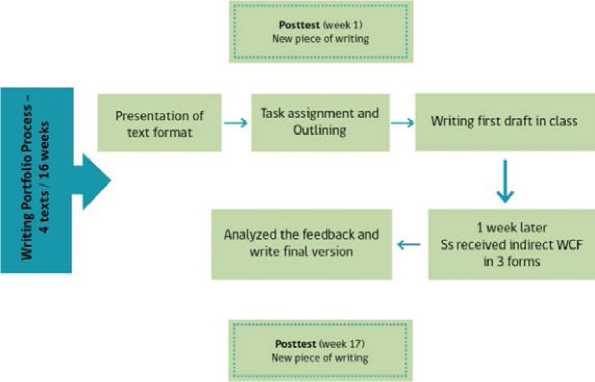
Figure 1: The Writing Portfolio Process
Table 3. Mean performance score (frequency of errors) for all participants
Pretest Postest
S.D. 1,348934439 1,07350657
Mean 0,789830508 0,666666667
84
Frequency oferrors pre and posttest

Pretest Postest
Figure 2. Frequency of errors for all participants in the pre and post test
1,00 0,80 0,60 0,40 0,20 0,00
Table 4 summarizes the mean and standard deviation for each of the five targeted linguistic errors (see also Figure 3). Three categories improved significantly for all groups; one belonging to grammar (the use of the indefinite article), and two from mechanics (use of capital letters and spelling). Table 4 summarizes the mean and standard deviation for each of the five targeted linguistic errors (see also Figure 3). Two categories improved; one belonging to grammar, the use of the indefinite article with a
Wilcoxon p-value of p = .005. The other category belongs to mechanics, the use of capital letters with p= 0.11. Wilcoxon signed-ranks indicated that posttest scores were significantly higher than pre-test scores for the categories of the use of the indefinite article and the use of capital letters.
The category subject verb agreement, which belongs to grammar, had an average frequency of M = 0.44 and SD = 0.86 in the pre-test subsequently
Table 4. (Average of error frequency for all participants)
|
Pretest |
Posttest | |||
|
Mean |
S.D. |
Mean |
S.D. | |
|
Subject omission |
0,27 |
0.55 |
0,78 |
1,09 |
|
Spelling |
1,56 |
1,91 |
1,30 |
1,41 |
|
Subject verb agreement |
0,44 |
0,86 |
0,48 |
0,82 |
|
Capital letters |
1,37 |
1,61 |
0,57 |
1,04 |
|
Indefinite article |
0,31 |
0,59 |
0,20 |
0,49 |
Figure 3. Error frequency per targeted linguistic error
85
Overall average pertargeted linguistic error
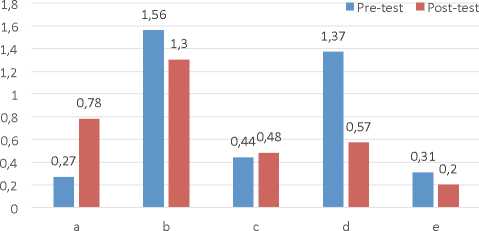
a) subject omission, b) spelling, c) subj verb agreement d) capital letters e) indefinite article
increased its error frequency in the posttest: M = 0.48 with a SD = 0.82 with a p = .456. Likewise, the category of subject omission showed an increase average of errors with M = 0.27 with SD = 0.55 in the pre-test compared to M = 0.78 with SD = 1.09 in the post-test with a p = 1.51. Finally, the category of spelling had a M = 1.56 and SD = 1.91 in the pre-test compared to M = 1.30 and SD = 1.41 in the post test with a p-value of p = .815.
Therefore, there were no statistically significant differences when using WCF on these three targeted linguistic errors: subject omission, subject verb agreement and spelling. Therefore, there was no differential effect when using WCF of any kind on these two targeted linguistic errors.
Which type of indirect WCF has the greatest impact on accuracy?
Table 5 and Figure 4 summarize the findings for type of feedback including average frequency and standard deviation. The findings show that Group 1, which received indirect WCF in the form of coding had a difference in the pretest M = 0.77 and SD = 1.23 compared to the posttest M = 0.65 and SD = 1.05. Likewise Group 3, showed less frequency of errors in the post test M = 0.88 and SD = 0.44 compared to the pretest M = 0.57 and SD = 1.17. On the other hand, Group 2, shows that the average frequency of errors increased in the post-test M = 0.88 and SD = 1.22 compared with the pre-test M = 0.85 with SD = 1.39.
A Wilcoxon signed-ranks test showed that the post-test scores were significantly higher than pre-test scores for group 3 (p = .004) which used feedback in the form of underlining compared to group 1 (p = .008) which used coding. There was not a statistically significance difference with group 2 (p = .109) which used the brief grammatical explanation as type of feedback.
Table 5. Average of frequency per type of feedback
|
Pretest |
Posttest | ||||
|
Group 1 Coding |
Group 2 Explanation |
Group 3 underlining |
Group 1 Coding |
Group 2 Explanation |
Group 3 Underlining |
|
Mean |
0,77 |
0,85 |
0,57 |
0,65 |
0,88 |
0,88 |
|
Standard deviation |
1,23 |
1,39 |
1,17 |
1,05 |
1,22 |
0,44 |
Figure 4. Average of errors per type of feedback
Average of errors per type of feedback
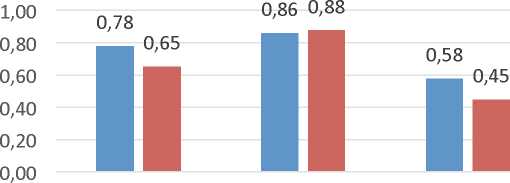
Grupo 1 Grupo 2 Grupo 3
■ Errores Pretest ■ Errores Postest
86
What are the perceptions of EFL learners towards the contribution of portfolio keeping and corrective feedback as combined learning strategies?
Data were collected from the two focus groups with students. Figure 5 shows the most frequent words from the interviews. Surprisingly, the word teacher was the most frequent. This study was carried out with first-year college students and in the focus groups they greatly value the support and guidance of teachers in the correction of their errors. Subsequently, the word error was constantly mentioned by students since they are aware that errors are inevitable and, at the same time, a key stage of the process of learning a second language. Other frequent words are: portfolio, everybody, section, and feedback. All of these terms played an important role in the implementation of a new teaching and learning strategy comprising corrective feedback and portfolio keeping.
Figure 5. Word cloud comprising the most frequent terms expressed in the interviews

Likewise, Figure 6 displays the information from the focus groups and suggests that the interviewed students considered WCF combined with a writing portfolio to be a valuable tool for two purposes: (1) for developing their writing skill, and (2) increasing their confidence as writers of EFL. For the former, they considered that portfolio keeping and error correction had contributed to (a) organization of the text through pre-writing activities, (b) expanded vocabulary, (c) knowledge of textual types, (d) grammar, and (e) mechanics of the language. Regarding the latter, the portfolio contributed considerably towards a feeling of confidence about writing upcoming new versions (drafts) or different types of written pieces. They pointed out that the consistent feedback of the teacher and the possibility of multiple-drafting contributed to their improvement. Moreover, they strongly believed that they acquired knowledge of academic writing appropriate to their level. Nevertheless, portfolio keeping also proved problematic. Students stated that they had trouble with time management and the amount of assigned words.
Discussion
Considering the increasing amount of studies on WCF using direct versus indirect feedback with an unfocused approach, the present study sought to contribute towards research by investigating the effect of three different types of indirect written corrective feedback on the accuracy of five targeted linguistic errors. Even though it was portfolio-based, the reformulation of different drafts was considered as a tool for learning rather than a source for data collection. As Chandler (2003) found in his study, “there was improvement on immediate revisions however texts written later showed no statistically significant differences in grammatical accuracy in relation to the type of feedback” (p. 280).
Overall, using indirect WCF showed a difference in the frequency of errors when comparing the pretest and post-test. It can therefore be considered as a successful strategy, as many researchers have already concluded (Bitchener & Knoch, 2010a, 2010b; Ellis, 2009; Ferris, 2006; Ferris et al., 2013; Sheen et al., 2009).
As Ferris (2006) and Lee (2004) suggested in their studies, the targeted categories were chosen through observation of the most recurrent grammatical problems students face at this university when writing in English. Thus, five errors that were rule-governed and could be acquired in the lowest stages of learning EFL were chosen on which intensive feedback could then be given. The use of indirect WCF seemed effective in three out of the five categories selected. We can observe that two of these (use of the indefinite article and
87
Figure 6. Concept map from focus groups with students
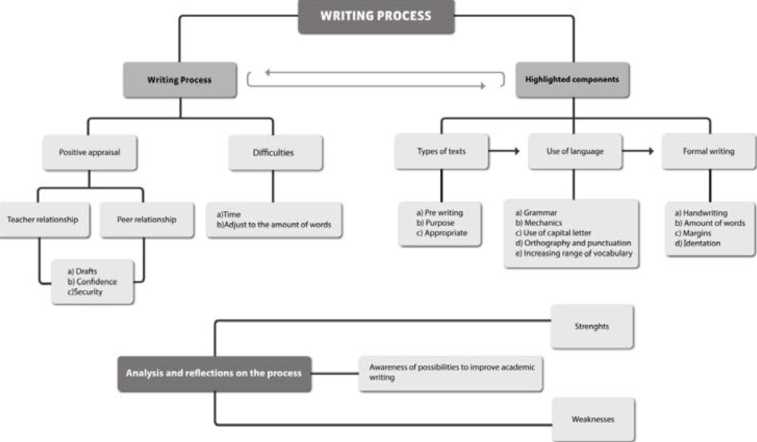
capital letters) are mainly “treatable” errors (Ferris, 2003, 2006). The rules are clear and students seem to apply them correctly in most cases—students made fewer errors in the posttest regarding these categories—even though there are still some interference problems with their mother tongue (Spanish). Targeting articles exclusively, Bitchener (2008) found similar results regarding the use of both the definite and indefinite article; however results cannot be fully compared since this study only includes the indirect article.
The linguistic error of spelling improved slightly across all groups. Orthography is a complicated issue for Spanish-speaking learners since the Spanish language has a phonetic orthography while English uses grapheme-to-morpheme concordance and grapheme-to-phoneme concordance (Campion, 2004). Thus, speakers of Spanish tend to write as they pronounce the words and, consequently, these results are not that unexpected.
Results showed that two linguistic errors belonging to the grammar classification from Storch and Tapper (2000)—errors of subject verb agreement and subject omission—did not improve on a new piece of writing in any of the three groups. On the contrary, the frequency of errors increased. Although these categories are very difficult for Spanish speaking learners, the results were surprising. It can be observed in this study that WCF was effective at the word level but did not show improvement at the syntactic level, at least not in the short term with lower proficiency level students.
When comparing the three groups, it can be seen that those who received indirect WCF in the form of underlining/highlighting improved the most in all five categories. These findings contradict Ferris et al. (2013), who state that “explicit CF (with labels, codes, or other metalinguistic explanation) may be more valuable for some students than unlabeled CF” (p. 309). It seemed here that the less guided the feedback was, the more strategies were developed by students in order to become efficient self-editors and they therefore improved their accuracy on the targeted linguistic categories. The feedback in the form of coding also improved; and the group which received feedback in the form of brief grammatical explanations did not show any difference, which supports the idea that more feedback is not necessarily beneficial to learning.
All of the aspects involved in written corrective feedback are equally important in the process of helping students improve their writing skills. The
88
selection of five targeted linguistic categories of treatable errors and the systematic written corrective feedback over time seem to have had an impact on some of the main grammatical problems teachers observed in the students from the study. In addition, the three types of feedback used seem to have developed different learning strategies in each intact group; therefore, all of them showed some improvement in accuracy. The type, form, and scope of written corrective feedback selected for this research contributed to the development of writing skills. The stages of writing production were internalized by students through the systematic and regular approach of the writing portfolio. Through the process of keeping track of their written work, students became active participants of their learning process and its assessment. Similarly, students seemed to adapt to the process of multiple drafting, feedback, and editing, and benefited from its consistency.
Accuracy improvement using WCF was supported and enhanced by keeping a writing portfolio, as the qualitative data demonstrated. It was beneficial to the improvement of grammar and vocabulary. Students were able to reflect on their strengths and weaknesses in relation to the different types of writing task through constant feedback. They believed that it contributed not only towards their writing skills, but also their attitudes towards the process of learning. Similar perceptions were described in Chang and Tseng’s (2011, as cited in Lam, 2013), which demonstrated that students considered portfolio keeping, and specifically portfolio assessment, as a beneficial tool for developing their writing skills and other linguistic aspects. Likewise, the results of this study showed that students were more confident about producing new texts because of the constant feedback given by the teacher. They felt that the teacher was a very effective resource.
Conclusions
This study is a contribution on the impact of combining indirect, focused written feedback and keeping a writing portfolio to improve writing skills in EFL. Results show that giving target and repetitive feedback on specific categories improve accuracy. Besides, the strategy of keeping a writing portfolio focuses and emphasizes all the stages of writing: planning (outline), drafting (writing different drafts and revising), and editing (correcting errors based on feedback received). The knowledge of these different phases of composition has given students confidence as writers. This was clearly stated in the focus groups.
Additionally, students showed a positive attitude towards corrective feedback as pointed out both in the focus group and the final reflections. They perceived consistent written corrective feedback as a factor to improve writing. Consequently, they value this strategy and expect to receive feedback on every draft. The teachers in this study were challenged to be consistent to a specific type of feedback and to specific error categories which is something difficult to cope with. Further research must be carried out to determine teachers’ deep perception on written feedback and the implications in their teaching practice and beliefs.
References
Aydin, S. (2010). EFL writers’ perceptions of portfolio keeping. Assessing Writing, 15, 194-203.
https://doi.org/10.1016/j.asw.2010.08.001
Baleghizadeh, S., & Dadashi, M. (2011). The effect of direct and indirect corrective feedback on students’ spelling errors. Profile, 13(1), 129-137.
Bitchener, J. (2008). Evidence in support of written corrective feedback. Journal of Second Language Writing, 17, 102-118.
https://doi.org/10.1016/j.jslw.2007.11.004
Bitchener, J., & Knoch, U. (2010a). The contribution of written corrective feedback to language development: A ten month investigation. Applied Linguistics, 31 (2), 193-214.
https://doi.org/10.1093/applin/amp016
Bitchener, J., & Knoch, U. (2010b). Written corrective feedback and advanced ESL learners. Journal of Second Language Writing, 19, 207-217.
https://doi.org/10.1016/j.jslw.2010.10.002
Bitchener, J., Young, S., & Cameron, D. (2005). The effect of different types of corrective feedback on ESL student writing. Journal of Second Language Writing, 14, 191-205.
https://doi.org/10.1016/j.jslw.2005.08.001
89
Campion, C. (2004). Spelling proficiency of native speakers of Spanish: A look at the influence of morpheme structures in spelling errors. The UCI undergraduate research journal. 19-26.
Chandler, J. (2003). The efficacy of various kinds of error feedback for improvement in the accuracy and fluency of L2 student writing. Journal of Second Language Writing, 12, 267-296.
https://doi. org/10.1016/S1060-3743(03)00038-9
Ellis, R. (2009). A typology of written corrective feedback types. ELT Journal, 63(2), 97-107.
https://doi.org/10.1093/elt/ccn023
Flick, U. (2004). Introducción a la investigación cualitativa. Madrid: Morata.
Lam, R. (2013). Two portfolio systems: EFL students’ perceptions of writing ability, text improvement, and feedback. Assessing Writing, 18(2), 132-153.
https://doi.org/10.1016/j.asw. 2012.10.003
Ferris, D. (1999). The case for grammar correction in L2 writing classes: A response to Truscott (1996). Journal of Second Journal Writing, 8(10), 1-11.
https://doi. org/10.1016/S 1060-3743(99)80110-6
Ferris, D. (2003). Response to student writing: Implications for second language students. Mahwah: Lawrence Erlbaum Associates, Inc., Publishers.
Ferris, D. (2006). Does error feedback help student writers? New evidence on short-and-long-term effects of written error correction. In K. Hyland & F Hyland (Eds.), Feedback in second language writing: Contexts and issues. Cambridge: Cambridge
University Press.
https://doi. org/10.1017/CBO9781139524742.007
Ferris, D., Liu, H., Sinha, A., & Senna, M. (2013). Written corrective feedback for individual L2 writers. The Journal of Second Language Writing, 22, 307-329.
https ://do i. org/10. 1016/j. js lw. 2012.09.009
Hyland, K., & Hyland, F (2006). Feedback in second language writing: Contexts and issues. Cambridge: Cambridge University Press.
https://doi. org/10.1017/CBO9781139524742
Kaminsky, D. E. (1993). Helping elementary English as a second language students to become independent learners by improving their reading strategies (Unpublished doctoral dissertation). Fort Lauderdale, FL: Nova University.
Kepner, C.G. (1991). An experiment in the relationship of types of written feedback to the development of second language writing skills. The Modern Language Journal, 75, 305-313.
https://doi.org/10.1111/j. 1540-4781.1991. tb05359.x
Lee, I. (2004). Error correction in L2 secondary writing classrooms: The case of Hong Kong. Journal of Second Language Writing, 13, 285-312.
https://doi.org/10.1016/j.jslw.2004.08.001
Lee, I. (2008). Understanding teachers’ written feedback practices in Hong Kong secondary classrooms. Journal of Second Language Writing, 17, 69-85.
https://doi.org/10.1016/j.jslw.2007.10.001
https://doi.org/10.1016/j.jslw.2007.12.001
Nezakatgoo, B. ( 2011). The effects of portfolio assessment on writing of EFL students. English Language Teaching, 4, 232-241.
https://doi.org/10.5539/elt.v4n2p231
Sheen, Y. (2007). The effect of focused written corrective feedback and language aptitude on ESL learner’s acquisition of articles. TEsOl Quarterly 41, 255-283.
https://doi.org/10.1002/j. 1545-7249.2007. tb00059.x
Sheen, Y, Wright, D., & Moldawa A. (2009). Differential effects of focused and unfocused written correction on the accurate use of grammatical forms by adult ESL learners. System, 37(4), 556-569.
https://doi.org/10.1016/j.system.2009.09.002
Storch, N., & Tapper, J. (2000). The focus of teacher and student concerns in discipline-specific writing by university students. Higher Education Research and Development, 19(3), 337-355.
https://doi.org/10.1080/758484345
Truscott, J. (1996). The case against grammar correction in L2 writing classes. Language Learning, 46, 327369.
https://doi.org/10.1111/j. 1467-1770.1996.tb01238.x
Truscott, J. (1999). The case for “the case against grammar correction in L2 writing classes”: A response to Ferris. Journal of Second Language Writing, 8(2), 111-122.
https://doi.org/10.1016/S1060-3743(99)80124-6
Truscott, J. (2007). The effect of error correction on learners’ ability to write accurately. Journal of Second Language Writing, 16, 255-272.
https://doi.org/10.1016/j.jslw.2007.06.003

90
Recibido: 25 de julio de 2016; Aceptado: 20 de diciembre de 2017
Resumen
Este artículo presenta un estudio mixto que compara la producción escrita de 60 estudiantes, divididos en tres grupos intactos en un programa de pedagogía en inglés de una universidad del sur de Chile. Se implementaron tres tipos de feedback correctivo escrito indirecto (FCE) y focalizado: el Grupo 1 usó códigos (n = 23), el Grupo 2 recibió una breve explicación gramatical (n = 22); y el Grupo 3 uso el subrayado (n = 15). Se utilizó diseño pre y post test con una intervención de 16 semanas y se entregó FCE en cinco categorías lingüísticas. Durante la clase de escritura existió instrucción explícita sobre gramática y conocimiento de géneros textuales, además de escribir varias versiones de un mismo texto escrito lo que adjuntaban a su portafolio de escritura para visualizar su progreso en el tiempo. Se calculó la frecuencia y desviación estándar de cada error en el pre y post test. Los datos cualitativos se recogieron de grupos focales mediante análisis de contenido. Los resultados muestran que dos de las cinco categorías lingüísticas presentaron una mejora significativa en términos de uso correcto, y existen diferencias entre los tipos de feedback. Las entrevistas indicaron que los estudiantes estaban satisfechos con el sistema del portafolio de escritura porque les permitía evaluar su progreso; valoraban el feedback sistemático y tenían una actitud positiva hacia el proceso de escritura centrado en el proceso y la posibilidad de escribir versiones mejoradas de un mismo texto.
Palabras clave :
FCE indirecto y focalizado, portafolio de escritura, versiones mejoradas, inglés como idioma extranjero.Abstract
This report describes a mixed-methods study comparing the writing performance of 60 EFL students in three intact groups during their first semester of an English undergraduate program at a university in the South of Chile. Three types of focused, indirect written corrective feedback were used: Group 1, coding (n = 23); Group 2, brief grammatical explanation (n = 22); and Group 3, underlining (n = 15). Feedback was given on five targeted linguistic categories. A pre-test was applied before the 16-week treatment took place, as well as a post-test. Students received explicit grammar training and knowledge of genres. Multiple-drafting was used in a writing-portfolio-based class that allowed them to see their progress over time. Frequency and standard deviation of errors (viz., subject omission, spelling, subject verb agreement, capital letters and indefinite articles) were calculated for the pre- and post-test. Qualitative data were collected from group semi-structured interviews and were analyzed using content analysis. Results show that two out of the five linguistic categories (use of capital letters and indefinite articles) improved significantly in terms of accuracy, and there are differences among types of feedback. Interviews indicated that students were satisfied with the writing portfolio system because it allowed them to keep track of their progress. In addition, they valued the systematic feedback and had a positive attitude towards multiple drafting and the writing process approach.
Keywords:
EFL, focused WCF, indirect, multiple drafting, writing portfolio.Introduction
Providing written corrective feedback (WCF) on linguistic and structural errors in learners’ writing in English as a foreign language is one of the main concerns of language teachers. This issue has been widely discussed over the last two decades. Some researchers have supported Truscott’s claim that error correction is unnecessary and even harmful for learners (Kepner, 1991; Truscott 1996, 1999, 2007) while there are enough studies that have suggested that the use of feedback on linguistic errors is beneficial for learners of English as a foreign language (Bitchener, 2008; Ferris, 2003, 2006; Hyland & Hyland, 2006; Sheen, 2007).
Written Corrective Feedback
Taking into account the considerable amount of literature (Bitchener, 2009; Bitchener & Knock, 2010b; Ferris 1999, 2003, 2006; Hyland & Hyland, 2006), it is suggested that receiving feedback has a greater impact on language accuracy than not receiving it at all. Therefore, the focus of the research has been on which type of WCF is the most beneficial. According to Ellis (2009) , WCF can be distinguished in terms of its directness, which ranges from direct (e.g., writing the correct form above the incorrect form) to indirect (e.g., using editing symbols, highlighting, etc.). However, there are still no conclusive findings showing whether direct corrective feedback is better than indirect corrective feedback. Chandler (2003) claimed that direct WCF is useful particularly for students whose level of English is rather low and therefore are not able to correct their own mistakes. On the other hand, many studies have produced findings on the efficacy of indirect WCF employing different options (e.g., coding, highlighting, brief grammar explanation, among others) with a view to achieving grammatical accuracy in the long term since students are able to see their own mistakes and correct them; therefore, they develop problem-solving skills and may become self-editors in the long run (Bitchener & Knoch, 2010a; Bitchener, Young, & Cameron, 2005; Ferris, 2006; Ellis, 2009; Sheen, 2007; Sheen, Wright, & Moldawa, 2009).
Focused versus unfocused feedback
Another important area of research is the range of error categories to be examined. Most studies have looked at the unfocused or comprehensive approach which included, in some cases, up to 15 different linguistic error categories. According to Bitchener and Knoch (2010a) , this is one of the causes for the inefficacy of using WCF, since it “may produce too much of a cognitive overload for learners to attend to” (p. 205). On the other hand, in focused or targeted WCF, the feedback is provided only on certain error types; some even including just one category, such as ‘articles’ (Sheen, 2007). Focused and repetitive targeting of specific grammatical problems identified by teachers has been shown to improve language accuracy (Baleghizadeh & Dadaski, 2011; Bitchener, 2008; Bitchener et al., 2005; Ellis, 2009; Sheen 2007; Sheen et al., 2009). However, this targeting must be for a specific period of time to avoid error fossilization in the long term.
Treatable vs. Untreatable Errors
Another issue is how to select specific categories on which to provide feedback. The first step should be students’ observation of their specific needs, but it also depends on the complexity and nature of the errors (Ferris, 2006; Lee, 2008). Ferris (2006) coined the terms ‘treatable’ and ‘untreatable’ errors. Treatable errors refer to those linguistic structures that are rule-governed; students acquire the structure in the short term by applying the rule properly. On the contrary, untreatable errors refer to those linguistic errors that are item-based; they require a deeper knowledge of the language such as, for example, errors of lexis. Written corrective feedback is a powerful strategy if the different aspects that are part of the process are consistent. To begin, making decisions related to the scope of feedback is crucial; choosing to give feedback to all linguistic categories or just a few based on students’ observations and not just the teacher or researcher’s preconceived ideas. Secondly, the type (direct or indirect) and form of feedback chosen (coding, brief grammar explanation or highlighting) has to be methodical and rigorous. The systematic approach of using WCF to improve writing skills can be enhanced by using a strategy that emphasizes the process of writing itself: the writing portfolio. Thus, this academic record would help self-awareness on frequent language errors along with the systematic feedback received. Due to this fact, students would improve accuracy.
Keeping a Writing Portfolio
Portfolio-based writing assessment has been used widely in colleges and universities as there is a relationship between teaching, learning, and assessment (Hamps-Lyon & Condon, 2000, cited in Nezakatgoo, 2011). Nezakatgoo (2011) claims that this assessment tool gives both teachers and students the possibility to evaluate how much the student’s writing has improved as well as the positive effects on students who obtain feedback while they are still working on a paper that has yet to be graded. The main characteristic for keeping portfolios is part of a wider list provided by Hamp-Lyons and Condon (2000, as cited in Lam, 2013). The portfolio gives students the opportunity to reflect and self-assess not only on their development in the writing process, but also on their progress in terms of linguistic accuracy.
By combining written corrective feedback with the strategy of keeping a writing portfolio we are focusing on the difficult process of improving writing in English as a foreign language, monitoring students’ improvement, and giving them the tools to be in charge of their own learning process. Results of studies indicate that using portfolios in writing can definitely contribute towards the development of writing skills (Aydin, 2010). Kaminsky (1993) found that students became independent in the literacy process, because they learned to read materials, dictionaries, and encyclopedias to ascertain the correct spelling or meaning of a word. From the perspective of EFL students’ perceptions, keeping a writing portfolio helped them noticeably with vocabulary and grammar knowledge, reading, research, and writing skills (Aydin, 2010).
Not many researchers, however, have investigated the impact of combining the strategies of keeping a writing portfolio and using WCF. Since there is evidence that students improve accuracy from rewriting the same text, this study only considered as evidence of improvement the results of the pre-test compared with a different written task for the post-test. As such, this research project set out to evaluate the impact of three different types of indirect written corrective feedback on the linguistic accuracy of EFL students by keeping a writing portfolio. The present study was guided by the following research questions:
-
Does indirect WCF contribute to linguistic accuracy in five specific categories over time?
-
Which type of indirect WCF has the greatest impact on accuracy?
-
What are the perceptions of EFL learners towards the contribution of portfolio keeping and corrective feedback as combined learning strategies?
The Study
Context
The study was conducted at a small university located in the south of Chile, where students rarely have direct contact with English-speaking populations outside of school. At this university, there is a focus on early disciplinary specialization, which means that students enroll at the university through a National Selection Test (PSU), choose a major based on their test score and interest, and study five or six years to get a bachelor’s degree by which they are certified to teach at high school level. Therefore, the participants of the study will become teachers of English as a foreign language after they have successfully completed five years of study. The syllabus includes: English language and culture, phonetics, literature, grammar, linguistics, didactics and curriculum planning, as well as a research thesis and a-semester-long practical in junior high or high school (from grades 7-12). Each course lasts one semester which is 17 weeks long.
Participants
The participants (N = 60) were students of the first year of an English teaching program and were assigned randomly to three intact groups at the beginning of the first semester 2016. This distribution was organized by the university and does not correspond to their level of proficiency or any other variable. Three types of focused, indirect written corrective feedback were divided among groups in the following way: Group 1, coding (n = 23); Group 2, brief grammatical explanation (n = 22); and Group 3, underlining (n = 15). Students were aged 18-25; 66% were women and 33% were men, and all spoke Spanish as their L1. They possessed an upper elementary level of English-A2 from the Common European Framework of Reference for Languages (CEFR)-and were enrolled in their first of 11 compulsory English language courses. This was a 10-hour per week course, where the four skills of the language were integrated. However, a two-hour writing session was established within the course in order to develop the treatment systematically. The three teachers in charge of these classes participated in the study; two of them were also the researchers. All of them have master’s degrees in either education or linguistics.
Method
This is a mixed-methods study comparing three types of indirect, focused written corrective feedback on portfolio-based tasks. A quasi experimental design, without a control group was implemented. Out of the three groups involved in the project, Group 1 received indirect WCF in the form of coding-editing symbols; Group 2 received feedback in the form of a brief grammatical explanation, while Group 3 received indirect feedback in the form of underlining errors (see Table 1).
* Adapted from Ellis (2009)
Table 1: Different types of Indirect Written Corrective Feedback

Design
This article reports part of a larger longitudinal study, to evaluate how first year undergraduate students’ writing performance improved over a 16-week period using WCF and keeping a writing portfolio. A year-long pilot was implemented the previous year in order to evaluate the study design (scope, linguistic categories, and types of feedback).
Targeted linguistic errors.
The analysis from the pilot project demonstrated the most recurrent mistakes which first-year students tend to make. From that list, five categories of treatable errors-linguistic components which follow prescribed rules that can be taught (Ferris, 2003, 2006)-were chosen to get intensive targeting through focused written corrective feedback. The five categories chosen were classified according to Storch and Tapper (2000) in two categories (see Table 2).
Table 2: Five targeted linguistic errors from the

Data Collection and Analysis
Two sources of data were used in this study. Quantitative data was collected from the pre- and post-test on a new piece of writing, while qualitative data was collected from the transcribed group interviews at the end of the writing portfolio process.
Pre- and post-test.
The frequency of linguistic errors on the five selected categories per 100 words was calculated on the pre-test and then compared with the post-test. The frequency was analyzed considering (a) the average of errors for the whole group, (b) the average of errors from the three different groups to check if there was a significant difference depending on the type of WCF they received, (c) the frequency of errors from the five categories targeted for the whole group, and finally, (d) the average of errors per category, per group. Standard deviation was calculated as well.
Focus groups.
There were two focus groups with six students participating in each group. Focus groups were conducted in the students’ native language in order to get as much information from them as possible and were moderated by a sociologist; none of the teachers/researchers were present so as to avoid intimidation. A semi-structured interview was carried out and recorded, with the prior consent of all participants. Subsequently, the interview was transcribed in a Microsoft Word document. According to Patton (1990, as cited in Flick, 2004), the focus group is a technique to collect data that allows the gathering of information in an effective way, with a certain amount of quality control over the data. Focus groups are normally composed of six to eight people. The data obtained from the focus group was structured in a concept map taking into account the discourse of the students to identify main categories for analysis.
Portfolio-based writing.
A two-hour session was dedicated exclusively to writing and was completed by all participants. This session was portfolio-based so every text students produced had to be filed in a hand-written portfolio to see their progress for themselves. At the beginning of the semester they were asked to complete a writing task of around 150 words (pre-test); they did not receive feedback on this text. Next, the students were asked to write four different texts, some of which were descriptive and some narrative.
At the beginning of the first class, a sample model was presented and explicit training on textual genres was included before a task was assigned. Students were first asked to do a prewriting activity (outlining, clustering, brainstorming or diagram). Teachers monitored their work and checked the outline to see if general organization was adequate so that students could start writing their first draft. They then started writing the assignment and were given 40 minutes. Teachers retrieved the texts (first draft) and indirect feedback was provided in the three different forms (coding, explanation, and underlining) depending on the group. Students received their first draft with feedback during the following writing session (seven days later). Immediately, students edited and reformulated their texts in about 40 minutes (final draft). The students then attached the text to the portfolio. This process was exactly the same for the four different writing texts throughout the term.
After they had finished the four texts with two drafts each, the students had to write an analysis and reflection on their performance throughout the term. They were asked to (a) analyze strengths and weaknesses, (b) revise their previous written work to show improvement through specific examples, and (c) indicate a future plan of action to improve their weaknesses. After the 16-week period they were requested to write a new piece of writing of around 150 words in 40 minutes (post-test) in order to compare them with the pretest; however, they did not receive any type of feedback on this text (see Figure 1).
Figure 1: The Writing Portfolio Process
Results
This section presents the results of the research study into the effect of indirect WCF on accuracy using three different types of feedback focused on five targeted linguistic errors. Findings will be reported in order to answer the research questions proposed for this study.
Does indirect WCF contribute to the linguistic accuracy of five specific categories over time?
Frequency analysis showed there is a slight difference in the frequency of errors for all groups considering the five targeted linguistic categories. The frequency and standard deviation for the whole group are shown in Table 3 and Figure 2. The pre-test had an average frequency of M = 0.78 with a SD = 1.34 errors per 100 words, while in the post-test the average decreased slowly to M = 0.66 with a SD = 1.07. A Kolmogorov Smirnov test was conducted to check whether data were normally distributed using large enough samples (≥30 or 40) in order to apply a Student’s t-test. Since distribution of data was not normal (p = <0.05) a Wilcoxon test of non-parametric data was applied instead. The difference in the pre and post-test (p = <0.001) indicates there is a statistically significant difference in the results.
The overall average levels of accuracy proved to be different; however, the average did not vary in all of the error categories in the post-test.
Table 3: Mean performance score (frequency of errors) for all participants

Figure 2: Frequency of errors for all participants in the pre and post test
Table 4 summarizes the mean and standard deviation for each of the five targeted linguistic errors (see also Figure 3). Three categories improved significantly for all groups; one belonging to grammar (the use of the indefinite article), and two from mechanics (use of capital letters and spelling). Table 4 summarizes the mean and standard deviation for each of the five targeted linguistic errors (see also Figure 3). Two categories improved; one belonging to grammar, the use of the indefinite article with a Wilcoxon p-value of p = .005. The other category belongs to mechanics, the use of capital letters with p= 0.11. Wilcoxon signed-ranks indicated that post-test scores were significantly higher than pre-test scores for the categories of the use of the indefinite article and the use of capital letters.
Table 4: (Average of error frequency for all participants)

Figure 3: Error frequency per targeted linguistic error
The category subject verb agreement, which belongs to grammar, had an average frequency of M = 0.44 and SD = 0.86 in the pre-test subsequently increased its error frequency in the posttest: M = 0.48 with a SD = 0.82 with a p = .456. Likewise, the category of subject omission showed an increase average of errors with M = 0.27 with SD = 0.55 in the pre-test compared to M = 0.78 with SD = 1.09 in the post-test with a p = 1.51. Finally, the category of spelling had a M = 1.56 and SD = 1.91 in the pre-test compared to M = 1.30 and SD = 1.41 in the post test with a p-value of p = .815.
Therefore, there were no statistically significant differences when using WCF on these three targeted linguistic errors: subject omission, subject verb agreement and spelling. Therefore, there was no differential effect when using WCF of any kind on these two targeted linguistic errors.
Which type of indirect WCF has the greatest impact on accuracy?
Table 5 and Figure 4 summarize the findings for type of feedback including average frequency and standard deviation. The findings show that Group 1, which received indirect WCF in the form of coding had a difference in the pretest M = 0.77 and SD = 1.23 compared to the post-test M = 0.65 and SD = 1.05. Likewise Group 3, showed less frequency of errors in the post test M = 0.88 and SD = 0.44 compared to the pretest M = 0.57 and SD = 1.17. On the other hand, Group 2, shows that the average frequency of errors increased in the post-test M = 0.88 and SD = 1.22 compared with the pre-test M = 0.85 with SD = 1.39.
A Wilcoxon signed-ranks test showed that the post-test scores were significantly higher than pre-test scores for group 3 (p = .004) which used feedback in the form of underlining compared to group 1 (p = .008) which used coding. There was not a statistically significance difference with group 2 (p = .109) which used the brief grammatical explanation as type of feedback.
Table 5: Average of frequency per type of feedback

Figure 4: Average of errors per type of feedback
What are the perceptions of EFL learners towards the contribution of portfolio keeping and corrective feedback as combined learning strategies?
Data were collected from the two focus groups with students. Figure 5 shows the most frequent words from the interviews. Surprisingly, the word teacher was the most frequent. This study was carried out with first-year college students and in the focus groups they greatly value the support and guidance of teachers in the correction of their errors. Subsequently, the word error was constantly mentioned by students since they are aware that errors are inevitable and, at the same time, a key stage of the process of learning a second language. Other frequent words are: portfolio, everybody, section, and feedback. All of these terms played an important role in the implementation of a new teaching and learning strategy comprising corrective feedback and portfolio keeping.
Figure 5: Word cloud comprising the most frequent terms expressed in the interviews
Likewise, Figure 6 displays the information from the focus groups and suggests that the interviewed students considered WCF combined with a writing portfolio to be a valuable tool for two purposes: (1) for developing their writing skill, and (2) increasing their confidence as writers of EFL. For the former, they considered that portfolio keeping and error correction had contributed to (a) organization of the text through pre-writing activities, (b) expanded vocabulary, (c) knowledge of textual types, (d) grammar, and (e) mechanics of the language. Regarding the latter, the portfolio contributed considerably towards a feeling of confidence about writing upcoming new versions (drafts) or different types of written pieces. They pointed out that the consistent feedback of the teacher and the possibility of multiple-drafting contributed to their improvement. Moreover, they strongly believed that they acquired knowledge of academic writing appropriate to their level. Nevertheless, portfolio keeping also proved problematic. Students stated that they had trouble with time management and the amount of assigned words.
Figure 6: Concept map from focus groups with students
Discussion
Considering the increasing amount of studies on WCF using direct versus indirect feedback with an unfocused approach, the present study sought to contribute towards research by investigating the effect of three different types of indirect written corrective feedback on the accuracy of five targeted linguistic errors. Even though it was portfolio-based, the reformulation of different drafts was considered as a tool for learning rather than a source for data collection. As Chandler (2003) found in his study, “there was improvement on immediate revisions however texts written later showed no statistically significant differences in grammatical accuracy in relation to the type of feedback” (p. 280).
Overall, using indirect WCF showed a difference in the frequency of errors when comparing the pre-test and post-test. It can therefore be considered as a successful strategy, as many researchers have already concluded (Bitchener & Knoch, 2010a, 2010b; Ellis, 2009; Ferris, 2006; Ferris et al., 2013; Sheen et al., 2009).
As Ferris (2006) and Lee (2004) suggested in their studies, the targeted categories were chosen through observation of the most recurrent grammatical problems students face at this university when writing in English. Thus, five errors that were rule-governed and could be acquired in the lowest stages of learning EFL were chosen on which intensive feedback could then be given. The use of indirect WCF seemed effective in three out of the five categories selected. We can observe that two of these (use of the indefinite article and capital letters) are mainly “treatable” errors (Ferris, 2003, 2006). The rules are clear and students seem to apply them correctly in most cases-students made fewer errors in the posttest regarding these categories-even though there are still some interference problems with their mother tongue (Spanish). Targeting articles exclusively, Bitchener (2008) found similar results regarding the use of both the definite and indefinite article; however results cannot be fully compared since this study only includes the indirect article.
The linguistic error of spelling improved slightly across all groups. Orthography is a complicated issue for Spanish-speaking learners since the Spanish language has a phonetic orthography while English uses grapheme-to-morpheme concordance and grapheme-to-phoneme concordance (Campion, 2004). Thus, speakers of Spanish tend to write as they pronounce the words and, consequently, these results are not that unexpected.
Results showed that two linguistic errors belonging to the grammar classification from Storch and Tapper (2000) -errors of subject verb agreement and subject omission-did not improve on a new piece of writing in any of the three groups. On the contrary, the frequency of errors increased. Although these categories are very difficult for Spanish speaking learners, the results were surprising. It can be observed in this study that WCF was effective at the word level but did not show improvement at the syntactic level, at least not in the short term with lower proficiency level students.
When comparing the three groups, it can be seen that those who received indirect WCF in the form of underlining/highlighting improved the most in all five categories. These findings contradict Ferris et al. (2013) , who state that “explicit CF (with labels, codes, or other metalinguistic explanation) may be more valuable for some students than unlabeled CF” (p. 309). It seemed here that the less guided the feedback was, the more strategies were developed by students in order to become efficient self-editors and they therefore improved their accuracy on the targeted linguistic categories. The feedback in the form of coding also improved; and the group which received feedback in the form of brief grammatical explanations did not show any difference, which supports the idea that more feedback is not necessarily beneficial to learning.
All of the aspects involved in written corrective feedback are equally important in the process of helping students improve their writing skills. The selection of five targeted linguistic categories of treatable errors and the systematic written corrective feedback over time seem to have had an impact on some of the main grammatical problems teachers observed in the students from the study. In addition, the three types of feedback used seem to have developed different learning strategies in each intact group; therefore, all of them showed some improvement in accuracy. The type, form, and scope of written corrective feedback selected for this research contributed to the development of writing skills. The stages of writing production were internalized by students through the systematic and regular approach of the writing portfolio. Through the process of keeping track of their written work, students became active participants of their learning process and its assessment. Similarly, students seemed to adapt to the process of multiple drafting, feedback, and editing, and benefited from its consistency.
Accuracy improvement using WCF was supported and enhanced by keeping a writing portfolio, as the qualitative data demonstrated. It was beneficial to the improvement of grammar and vocabulary. Students were able to reflect on their strengths and weaknesses in relation to the different types of writing task through constant feedback. They believed that it contributed not only towards their writing skills, but also their attitudes towards the process of learning. Similar perceptions were described in Chang and Tseng’s (2011, as cited in Lam, 2013), which demonstrated that students considered portfolio keeping, and specifically portfolio assessment, as a beneficial tool for developing their writing skills and other linguistic aspects. Likewise, the results of this study showed that students were more confident about producing new texts because of the constant feedback given by the teacher. They felt that the teacher was a very effective resource.
Conclusions
This study is a contribution on the impact of combining indirect, focused written feedback and keeping a writing portfolio to improve writing skills in EFL. Results show that giving target and repetitive feedback on specific categories improve accuracy. Besides, the strategy of keeping a writing portfolio focuses and emphasizes all the stages of writing: planning (outline), drafting (writing different drafts and revising), and editing (correcting errors based on feedback received). The knowledge of these different phases of composition has given students confidence as writers. This was clearly stated in the focus groups.
Additionally, students showed a positive attitude towards corrective feedback as pointed out both in the focus group and the final reflections. They perceived consistent written corrective feedback as a factor to improve writing. Consequently, they value this strategy and expect to receive feedback on every draft. The teachers in this study were challenged to be consistent to a specific type of feedback and to specific error categories which is something difficult to cope with. Further research must be carried out to determine teachers’ deep perception on written feedback and the implications in their teaching practice and beliefs.
References
Metrics
License
This work is licensed under a Creative Commons Attribution-NonCommercial-NoDerivatives 4.0 International License.
Attribution — You must give appropriate credit, provide a link to the license, and indicate if changes were made. You may do so in any reasonable manner, but not in any way that suggests the licensor endorses you or your use.
NonCommercial — You may not use the material for commercial purposes.
NoDerivatives — If you remix, transform, or build upon the material, you may not distribute the modified material.
The journal allow the author(s) to hold the copyright without restrictions. Also, The Colombian Apllied Linguistics Journal will allow the author(s) to retain publishing rights without restrictions.

